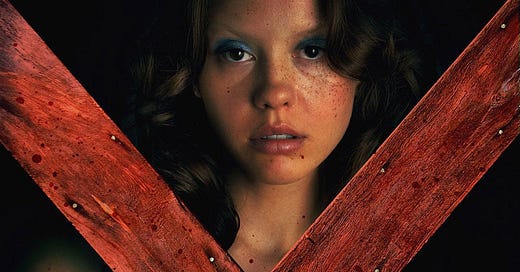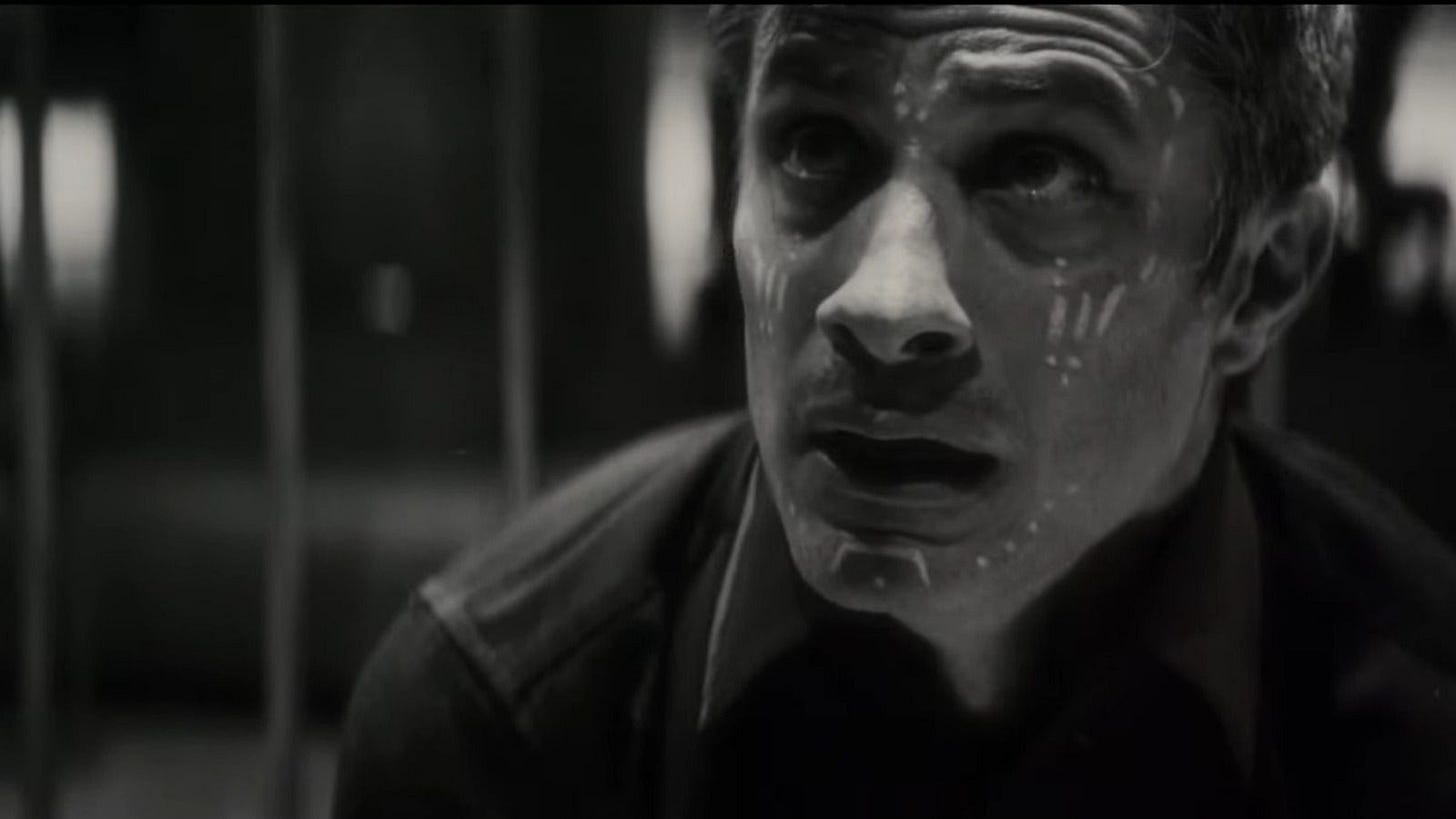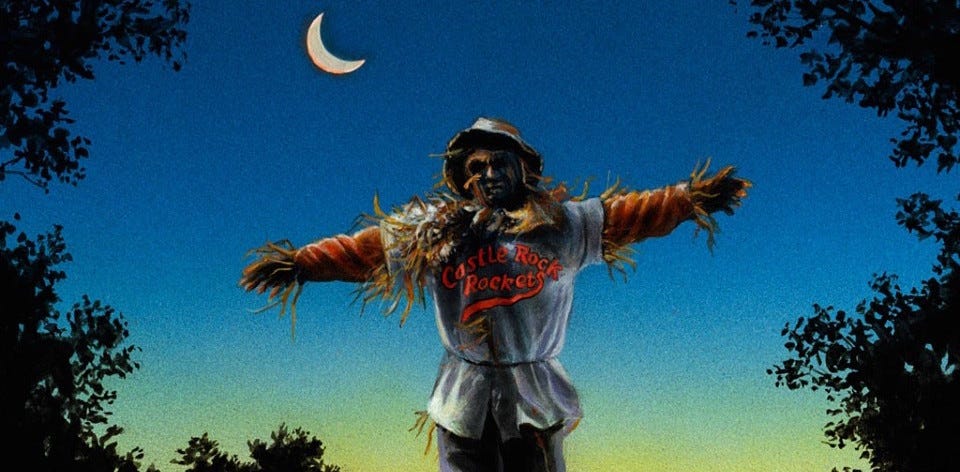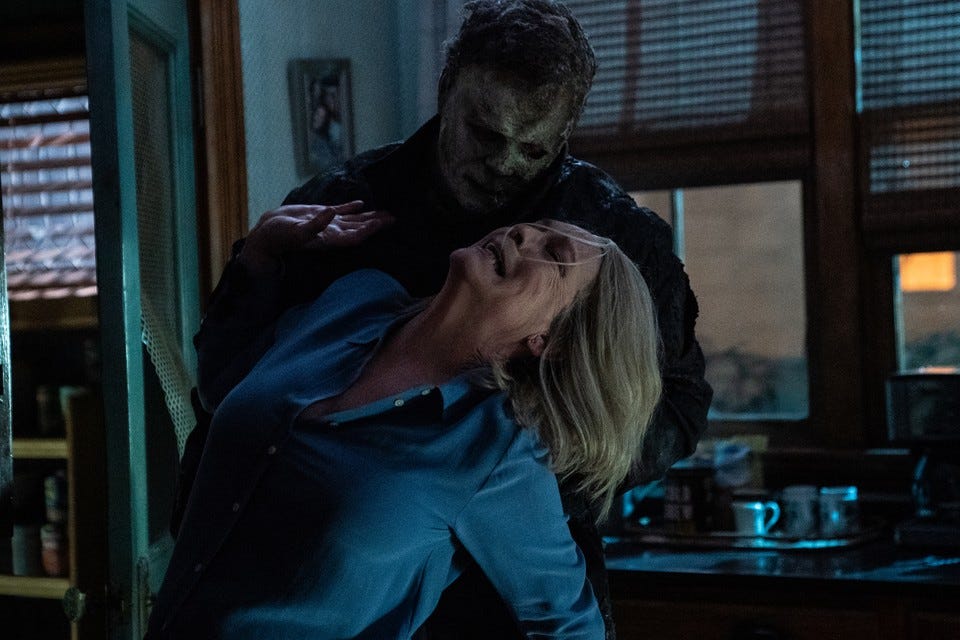'X' just misses the spot
Talking Ti West's slasher, werewolves (by night!) and the final (lol) Michal Myers movie
Last week, I announced that I was changing up this newsletter a little bit, pulling back on the pressure I was putting on myself to get things out several times a week. I think the shape that this week’s entry hits is a lot more in line with how I enjoy putting these together. It’s really hard to try and write what were, in effect, two or three lengthy essays a week, particularly with a full-time career, two young kids and several other obligations. But rounding everything into one digest? Yeah, I can do that. And if I get more out, that’s just a bonus for us all, right?
If you haven’t listened to this week’s We’re Watching Here, in which Perry and I talked about what our picks for the 2022 Sight and Sound poll would be, I encourage you go to back to Monday’s newsletter or subscribe on iTunes and Spotify. It was a fun conversation about some of the best films ever made, and I’m curious to hear what others might pick, so leave a comment.
This week, most the things I talk about are horror-related, in line with the season. I’m not a horror obsessive, but in October I love the opportunity to spend some time in the genre, and I’m sure as we get closer to Halloween I’ll have some more horror-related stuff to write about. But there are also other movies that will be coming out that I want to dive into, and my wife and I finally had a serious talk about how neglectful we’ve been of our TV shows, and I think soon we’re going to be setting aside time to finish up the latest seasons of “What We Do in the Shadows” and “Only Murders in the Building” and get past episode one in “Rings of Power.” Plus, I still haven’t watched a single episode of “She-Hulk.”
But for now, let’s talk about some slashers and werewolves.
‘X’ just misses the spot
I really wanted to love this one. I know a lot of my fellow critics adore Ti West’s film from earlier this year, and it comes so close to working for its first hour. But the end result just further proves my suspicions that some genres can’t be classed up.
X is West’s homage to, among other things, The Texas Chain Saw Massacre and, in its best moments, it achieves the sweaty, fetid feel of Tobe Hooper’s masterpiece. In West’s story, a group of young people head to a Texas farm one summer in the ‘70s to shoot an adult movie, unaware that the property is owned by an old man and his wife with their own hang-ups. As you can imagine, cultures clash.
West specializes in slow burns that erupt into full-blown terror, and he has an uncanny ability to meticulously re-create the tones of beloved period pieces. For its first hour, X plays to his strengths, reveling in the sweaty atmosphere of ‘70s exploitation flicks and tiptoeing into the transgressive while still remaining gorgeously composed and quietly thoughtful.
I’m leery of most films not called Boogie Nights that focus on the makers of adult films, as they too often are an opportunity to engage in sleaze. And there’s a case to be made that West lingers a bit too long on the sex scenes, straddling the line between ogling and artistic statement. And yet, I wouldn’t call the sex and nudity gratuitous, although I’d warn that it is graphic.
The film’s most intriguing aspect is the way it contrasts the protagonists’ comfort with their bodies and the sexual liberation of the ‘70s with the aging of the farmer, Howard, and his wife, Pearl. And it’s here that we need to stop and talk about Mia Goth, who’s been quietly doing solid work for the past several years but is a revelation here as the film’s lead, Maxine, while also doing double duty under heavy makeup as the aging Pearl.
Maxine is a young woman who dreams of stardom and vows to become a sex symbol, and Goth plays her with youthful charisma that belies an icy center. It’s a fantastic performance, but Goth is even better as Pearl, who becomes fascinated with her young tenant. Rather than turn Pearl into a monster, the film treats her sympathetically. It’s heavily implied there’s some sort of link between her and Maxine; maybe not supernatural or familiar, but Pearl sees her own youthful wishes, ambitions and opportunities in this young starlet, and it stirs up regrets and insecurities. In the corner, a television constantly blares the warnings of a fire-and-brimstone preaching, going on screeds about moral depravity and sexual corruption.
The film flirts with profundity concerning aging, the myth of youthful freedom and the dangers of curdled religion, and paired with an engaging cast, gorgeous cinematography and West’s deliberate pacing, it gets under the skin. We know the carefree youths will collide with Howard and Pearl’s frustrations and regrets, and the only question is how. It’s eerie before it ever becomes violent and troubling before anything truly sinister happens. West weaves a tight coil that feels sweltering and on the edge of being truly disturbing, and his shot composition is meticulous. The film feels special. . . .
… And then, in its final 40 minutes, it turns into a slasher film.
There’s a subplot in X about the film-within-the-film’s director, who aspires to make an adult film that is not just pornography, but legitimate art. I feel like West is trying to do the same for the slasher film. While I’d argue that pornography is too morally bankrupt to result in actual art, I can entertain the argument that a slasher movie could aspire to more than just cheap thrills. While there are many, many, many horrible ones, the subgenre often delivers some well-crafted scares and gross-out moments that allow special effects teams to indulge the more grotesque sides of their imaginations. And the best slasher films have something deeper behind the blood and guts. The Texas Chain Saw Massacre resonates because it is a head-on engagement with the fact that our world is often filled with unspeakable, unforgivable horrors. Halloween is best when it taps into our deepest fears that our safest places can be invaded. And the scariest thing about A Nightmare on Elm Street is the suggestion that even our sleep can’t provide a respite from danger.
And there’s the suggestion lurking in X that Pearl, Howard or both will reach a breaking point as their own self-disgust, regret and fear of mortality collide as they watch these beautiful young people flaunt their bodies and indulge in things they never could. And because I knew the film had a slasher element, I braced myself for an onslaught of body horror as they wrought carnage on these nubile visitors.
[spoilers for X follow]
Instead, the film’s final act abandons its eerie, atmospheric vibe to turn into what Ebert called a “geek show.” Pearl and Howard are both revealed as killers, although I was never quite clear whether they were in cahoots or if they were both indulging their own latent homicidal tendencies. The film has done such a solid job building sympathy for Pearl and treating her with humanity, which it tosses away in favor of giving us another movie monster. It’s deflating and turns what had been a special genre movie into another run-of-the-mill slasher, not even allowing the film’s kills to feel like they’re part of the exploration of aging, beauty and the eventual running down of our bodies.
The deliberate pacing and eerie beauty of the first hour is dispensed in favor of rushing through a variety of bloody but unremarkable death scenes (one exception: the bit with the alligator is pretty solid). It abandons the most interesting aspects of the film in favor of a bait and switch, turning it into the type of film we’ve seen done to death. It’s not that it’s a bad slasher movie; West knows his way around the genre. It’s just that it’s deflating to see it abandon the more interesting approach for this, and the two films West is attempting never come together organically.
That said, Goth continues to kill it through the end of the film and its final moments reveal a tantalizing background and an edge to Maxine that I imagine we’re going to see more of next year in the already announced sequel, MaxXxine. And I’m more curious than ever about the already released prequel, Pearl; any chance to see Goth inhabit this character again is worth it.
X isn’t an awful film. The problem is that it’s a very good one that settles for being alright. It’s disappointing in a different way than a truly bad film.
Werewolf? There wolf. When wolf? By night.
Marvel’s Werewolf By Night, now available on Disney+ is slight by design. Less than an hour long, it’s the streamer’s version of a holiday special (last year, they released a Muppets Halloween thing and next year, Marvel’s going to give us a Guardians of the Galaxy special). So those looking for cameos from big Marvel names, reveals about the next chapter of the Marvel Cinematic Universe or any large-scale franchise shakeups should check their expectations at the door.
But as a one-off piffle that opens the door to a new, spooky corner of the MCU, it gets the job done. The story is paper-thin: a group of monster hunters gathers at a mysterious mansion in the middle of the night. There’s something about a family curse and, because this is Marvel, a magic stone. Then the hunters are let loose after a mysterious beast. One of those hunters? A mild-mannered named Jack (Gabriel Garcia Bernal), who secretly lives under a werewolf’s curse.
More than anything else, Werewolf By Night is a style exercise, and I’m here for that. Composer Michael Giacchino does double duty; his score is evocative of 1930s monster flicks and, serving as director, he captures the look and feel of those movies as well. I loved the black-and-white cinematography, the deep shadows, the flashes of lightning, the fake peels of thunder. We don’t get to see much of the werewolf (by night) but the shadowy transformation and practical effects-assisted design are impressive.
This is the type of weird experiment that Disney+ is designed for, allowing Marvel to explore some of its weirder corners and actually let a filmmaker play around with aesthetics and tone. The quips are still there, and I must admit I’m growing a bit tired of the franchise’s use of humor as a crutch. But Bernal is a compelling lead and I wouldn’t mind more of Jack or his beastly friend, Ted, showing up in future installments. I just hope that if they revisit the scarier regions of the MCU, they allow filmmakers to bring their playfulness with them to the big screen instead of forcing it into the Marvel brand.
King of Halloween (on the page)
When I decided to pull back on how many times a week I published this newsletter, I knew my ongoing series would take a hit. I still plan on doing some form of Franchise Friday, but it might just come all in one newsletter. For October, that meant I’d probably have to pull back on King of Halloween, my look at Stephen King adaptations, at least as a weekly publication. I still hope to watch a few over the month of October, and I’m sure I’ll write about them here.
However, pulling back on how much I write has freed up some time to read, which has been great. A few years back, I started a habit of reading one horror short story collection every October. Two years ago, it was Stephen King’s Night Shift, and I kept it in the family last year for Joe Hill’s 21st Century Ghosts. This year, I’m bouncing back to King and doing his 1993 collection Nightmares and Dreamscapes, and four stories in, I’m loving my choice.
King is one of the few working novelists who still regularly writes and publishes short stories, and I quite enjoyed his last novella collection, If It Bleeds. But I particularly like when he digs in to stories that are 50 pages or less, as he’s got a skill for cranking out scary, muscular and sometimes very mean tales. And so far, Nightmares and Dreamscapes is delivering.
The first story, “Dolan’s Cadillac,” is not a supernatural story at all, but one of King’s occasional pulp works. It’s the story of a man whose wife was killed by a mobster in retaliation for testifying at his trial. Over the course of one summer and two long nights, the usually meek schoolteacher learns the ins and outs of road construction in the desert, laying a trap for the kingpin. It’s on of King’s more process-driven stories, honing in on the meticulous details of construction work and road engineering. It all pays off in a final stretch that is cathartic and dark. It’s lean, mean little read.
Next up is “The End of the Whole Mess,” King’s take on Flowers for Algernon. Told in first person (like many of King’s best stories), it concerns a man whose gifted brother has done something that seems, on the surface, miraculous, but unleashes its own nightmarish consequences. King leans less on the horrific and more on the emotional in this surprisingly tender story, and its tale of two brothers trying to find a solution to a broken, angry world feels even more resonant in our crazy times. It’s interesting but fairly unmemorable until it gets to its final few pages, when King plays with a literary device that allows us to understand our narrator’s rapidly diminishing capacity and lends it a wallop of urgency and emotion. King’s early work deservedly gets a lot of credit for the scares but he doesn’t get as much recognition for his knack with emotions, and this one ends on a note that is more heartbreaking than horrifying, and it sticks to the ribs.
I almost feel bad for reading “Suffer the Little Children” in our church lobby while my daughter was at her Wednesday night class. This is a bleak, nasty little piece of work, with one of King’s most unsettling endings. An old teacher begins to suspect there’s something off, possibly demonic, with her latest class. From there, she spirals into a nervous breakdown and attempts to fight the evil on her own. In his notes, King talks about the Bradbury-esque tone he strove for, and the story is fairly adept at capturing the sense of evil that might lurk behind innocent facades. But even for King, the climax to this story is dark, and feels a bit too much in our days of school violence and active shooters.
The last one I read was “The Night Flier,” which might be one of my favorite King stories. It follows a tabloid journalist chasing a serial killer who is flying into airports to search for victims. Only, it seems this serial killer also wears a red-and-black cloak, travels with a load of dirt, and has a thirst for blood. I liked the jaded journalist at the story’s center, and I particularly enjoyed the structure of this story, centered around the writer’s final approach to a Delaware airport while he looks back on the trail he’s traced. The story’s final passages are big, scary, cinematic stuff and it’s climax is gory, fun. I know this was made into a low-budget movie years back, but it seems ripe for a cinematic revisit (and even so, I might add this one to my King of Halloween viewing lineup out of curiosity).
“Halloween Ends”? Sure, Jan.
Does anyone really believe we’ve seen the end of Michael Myers and the William Shatner mask? I’m not even fully convinced Jamie Lee Curtis has made her last appearance as Laurie Strode. But it’s October again, and that must mean there’s a new Halloween. You can head on over to CinemaNerdz to read my review of the newest entry, Halloween Ends. I really hated latest year’s Halloween Kills, but was surprised how much fun I had with this latest entry. “Good” isn’t really a term you can usually use with the slasher genre and, as with X, this is a film that’s at its worst when it can’t decide whether it’s a fun slasher or aspires to something more. But David Gordon Greene’s latest has two or three great kills, an interesting idea at its center, and tries to convince us that we’ve see the last of The Shape. I highly doubt that last part, but I appreciate the attempt.
And that’s it for this week! We’ll be back next Friday at the very latest! And I’d love to hear about your Spooky Season viewing and reading!








